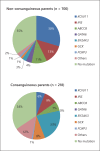Diabetes mellitus in neonates and infants: genetic heterogeneity, clinical approach to diagnosis, and therapeutic options
- PMID: 24051999
- PMCID: PMC3884170
- DOI: 10.1159/000354219
Diabetes mellitus in neonates and infants: genetic heterogeneity, clinical approach to diagnosis, and therapeutic options
Abstract
Over the last decade, we have witnessed major advances in the understanding of the molecular basis of neonatal and infancy-onset diabetes. It is now widely accepted that diabetes presenting before 6 months of age is unlikely to be autoimmune type 1 diabetes. The vast majority of such patients will have a monogenic disorder responsible for the disease and, in some of them, also for a number of other associated extrapancreatic clinical features. Reaching a molecular diagnosis will have immediate clinical consequences for about half of affected patients, as identification of a mutation in either of the two genes encoding the ATP-sensitive potassium channel allows switching from insulin injections to oral sulphonylureas. It also facilitates genetic counselling within the affected families and predicts clinical prognosis. Importantly, monogenic diabetes seems not to be limited to the first 6 months but extends to some extent into the second half of the first year of life, when type 1 diabetes is the more common cause of diabetes. From a scientific perspective, the identification of novel genetic aetiologies has provided important new knowledge regarding the development and function of the human pancreas.
Copyright © 2013 S. Karger AG, Basel.
Figures



References
-
- Schwartzman J, Crusius ME, Beirne DP. Diabetes mellitus in infants under one year of age; report of a case and review of the literature. Am J Dis Child. 1947;74:587–606. - PubMed
-
- Iafusco D, Stazi MA, Cotichini R, Cotellessa M, Martinucci ME, Mazzella M, Cherubini V, Barbetti F, Martinetti M, Cerutti F, Prisco F, Early Onset Diabetes Study Group of the Italian Society of Paediatric Endocrinology and Diabetology Permanent diabetes mellitus in the first year of life. Diabetologia. 2002;45:798–804. erratum in Diabetologia 2003;46:140. - PubMed
-
- Rosenbauer J, Herzig P, von Kries R, Neu A, Giani G. Temporal, seasonal, and geographical incidence patterns of type I diabetes mellitus in children under 5 years of age in Germany. Diabetologia. 1999;42:1055–1059. - PubMed
-
- Grulich-Henn J, Wagner V, Thon A, Schober E, Marg W, Kapellen TM, Haberland H, Raile K, Ellard S, Flanagan SE, Hattersley AT, Holl RW. Entities and frequency of neonatal diabetes: data from the diabetes documentation and quality management system (DPV) Diabet Med. 2010;27:709–712. - PubMed
Publication types
MeSH terms
Substances
Grants and funding
LinkOut - more resources
Full Text Sources
Other Literature Sources
Medical

